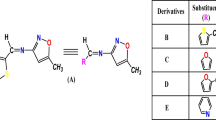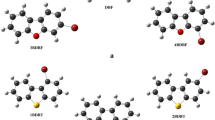Abstract
Herein theoretical study, we designed sixteen conjugated arylated α, β unsaturated carbonyl thiophene based compounds by using density functional theory (DFT) and time-dependent (TD) density functional theory at modified Perdue Wang density functional MPW1PW91 functional with 6-31G (d, p) basis set. Ground and excited state geometries, electronic and photophysical characteristics of designed molecules are evaluated by assuming the electron-donating and electron-withdrawing effects of the substituents that are attached to these newly designed molecules. Furthermore, calculation of vibrational spectra, time-dependent effect, isotopic substitution effect and force constant along with thermodynamic quantities are also carried out by using MOPAC (Molecular Orbital Package) with strong implementation of semi empirical Hamiltonians. The results reveal that our designed molecules can be a good candidates for electroluminescent and optoelectronic devices for further fabrication of solar cell devices.



Similar content being viewed by others
References
Roux MV et al (2007) Thermochemistry of 2-and 3-acetylthiophenes: calorimetric and computational study. J Phys Chem A 111(43):11084–11092
Ali U et al (2020) Molecular designing of naphthalene diimide based fullerene-free small organic solar cell-acceptors with high photovoltaic performance by density functional theory. Spectrochim Acta A Mol Biomol Spectrosc 228:117685
Hosmane RS, Liebman JF (1991) Aromaticity of heterocycles: experimental realization of dewar-breslow definition of aromaticity. Tetrahedron Lett 32(32):3949–3952
Sharipov AK (2002) Production of thiophenes from products of refining of medium—sulfur crude oils. Chem Technol Fuels Oils 38(5):340–344
Ali U et al (2019) Designing difluoro substituted benzene ring based fullerene free acceptors for small naphthalene di-imide based molecules with DFT approaches. Opt Quant Electron 51(10):332
Kropp KG, Fedorak PM (1998) A review of the occurrence, toxicity, and biodegradation of condensed thiophenes found in petroleum. Can J Microbiol 44(7):605–622
Roux MV et al (2007) Experimental and computational thermochemical study of 2-and 3-thiopheneacetic acid methyl esters. J Phys Chem A 111(24):5280–5286
Choong IC et al (2002) Identification of potent and selective small-molecule inhibitors of caspase-3 through the use of extended tethering and structure-based drug design. J Med Chem 45(23):5005–5022
Ali U et al (2019) Benchmark study of benzamide derivatives and four novel theoretically designed (L1, L2, L3, and L4) ligands and evaluation of their biological properties by DFT approaches. J Mol Model 25(8):223
Polshettiwar V, Varma RS (2008) Aqueous microwave chemistry: a clean and green synthetic tool for rapid drug discovery. Chem Soc Rev 37(8):1546–1557
Hussain Z, Shoaib M, Ali U, Ramzan H, Ali M, Tariq A, Naqash M (2020) Theoretical study of isoxazoles and their derivatives for evaluating its pharmaceutical properties with density functional theory. J Comput Chem Mol Model 4(3):415–426
Rost C et al (2004) Ambipolar light-emitting organic field-effect transistor. Appl Phys Lett 85(9):1613–1615
Ajmal M et al (2019) Designing indaceno thiophene–based three new molecules containing non-fullerene acceptors as strong electron withdrawing groups with DFT approaches. J Mol Model 25(10):311
Gudasi KB et al (2006) X-ray crystallographic and 2D HETCOR NMR studies of 2-acetylthiophene-o-aminobenzoylhydrazone: synthesis and spectral studies of its transition metal complexes. J Mol Struct 788(1):22–29
Barbarella G, Melucci M, Sotgiu G (2005) The versatile thiophene: an overview of recent research on thiophene-based materials. Adv Mater 17(13):1581–1593
Perepichka IF et al (2005) Light-emitting polythiophenes. Adv Mater 17(19):2281–2305
Saeed U et al (2019) Designation and match of non-fullerene acceptors with X-shaped donors toward organic solar cells. ChemistrySelect 4(13):3654–3664
Ali U, Javed A, Tallat A, Iqbal J, Raza A (2019) Molecular designing of four high performance pyrazine-based non-fullerene acceptor materials with naphthalene diimide-based small organic solar cells. J Mol Model 25(2)
Asiri AM (2003) Synthesis and characterisation of new coumarin derivatives as ultraviolet absorbers. Pigm Resin Technol 32(5):326–330
Muniz-Miranda F et al (2015) Benchmarking TD-DFT against vibrationally resolved absorption spectra at room temperature: 7-aminocoumarins as test cases. J Chem Theory Comput 11(11):5371–5384
Adamo C, Barone V (1998) Exchange functionals with improved long-range behavior and adiabatic connection methods without adjustable parameters: the m PW and m PW1PW models. J Chem Phys 108(2):664–675
Cave RJ, Burke K, Castner EW (2002) Theoretical investigation of the ground and excited states of coumarin 151 and coumarin 120. J Phys Chem A 106(40):9294–9305
Pedone A (2013) Role of solvent on charge transfer in 7-aminocoumarin dyes: new hints from TD-CAM-B3LYP and state specific PCM calculations. J Chem Theory Comput 9(9):4087–4096
Shoaib M et al Theoretical investigation of perylene diimide derivatives as acceptors to match with benzodithiophene based donors for organic photovoltaic devices. Z Phys Chem
Nie H et al (2017) Tetraphenylfuran: aggregation-induced emission or aggregation-caused quenching? Mater Chem Front 1(6):1125–1129
Manzoor F et al (2018) Theoretical calculations of the optical and electronic properties of dithienosilole-and dithiophene-based donor materials for organic solar cells. ChemistrySelect 3(5):1593–1601
Bourass M et al (2017) DFT/TD-DFT characterization of conjugational electronic structures and spectral properties of materials based on thieno [3,2-b][1] benzothiophene for organic photovoltaic and solar cell applications. J Saudi Chem Soc 21(5):563–574
Pearson RG (1986) Absolute electronegativity and hardness correlated with molecular orbital theory. Proc Natl Acad Sci U S A 83(22):8440–8441
Acknowledgments
The authors acknowledged the technical support for this computational analysis provided by Punjab Bio-Energy Institute (PBI), Faisalabad and Department of Chemistry, University of Agriculture, Faisalabad (UAF), 38040, Pakistan.
Author information
Authors and Affiliations
Corresponding author
Ethics declarations
Conflict of interest
The authors declare that they have no conflict of interest.
Additional information
Publisher’s note
Springer Nature remains neutral with regard to jurisdictional claims in published maps and institutional affiliations.
Supplementary information
ESM 1
(DOCX 912 kb)
Rights and permissions
About this article
Cite this article
Iftikhar, T., Ali, U. & Shoaib, M. Theoretical study of α, β unsaturated carbonyl thiophene derivatives to investigate optoelectronic properties toward organic photovoltaics. J Mol Model 26, 342 (2020). https://doi.org/10.1007/s00894-020-04597-w
Received:
Accepted:
Published:
DOI: https://doi.org/10.1007/s00894-020-04597-w




